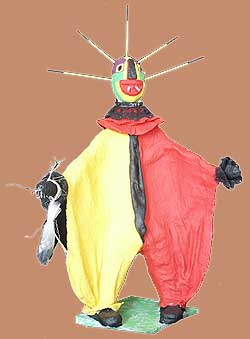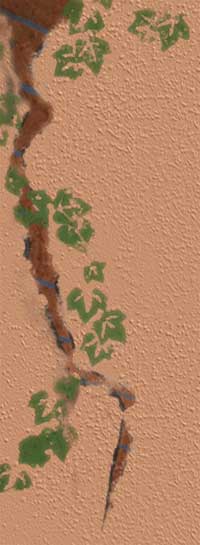Máscaras Vejigante
Las máscaras vejigantes son de estilo borinqueño tradicional. Hay dos tipos: cartón piedra ( del área europea de Ponce) y esqueleto de coco ( del área africano de Loiza). Típicamente varios cuernos estan colocados en la parte más alta de la másacara y son pintados con colores brillantes. Lilly hace sus propias máscaras cartónes piedras usando moldes hechas a mano y después pone jalea de petróleo encima y añade varias tapas de periódico. Para moldear las máscaras de estilo Loiza, Lilly crea un molde usando un coco y luego la transforma en una calabera usando plastilina. Ella pinta diseños de colores sobre la máscara usando pinturas acrílicas.
Se llevan máscaras vejigantes cada 26-28 de julio durante las fiestas del Apostol Santiago. Las bailarinas se ponen máscaras para espantar a los niños y entretener a la gente. Tradicionalmente llevan vesículas de vaca y las sacuden cuando caminan por la calle y cantan "coco coco coco coco vejigante come coco." Lilly creó una muñeca vejigante usando cartón de piedra para la máscara y gasa para el disfraz.
Lilly creó otros estilos como máscaras pintadas de malla y máscaras más pequeñas que se esculpe y molde.
 Vejigante Masks Vejigante Masks
Vejigante masks are a traditional style of Puerto Rican masks and are of two types: papier mache (from the more European-influenced area of Ponce) and coconut shell (from the more African-influenced area of Loiza). Typically several horns jut from the top of the figure's face and they are painted bright colors. Lilly makes her own papier mache masks using hand-made molds and then spreading petroleum jelly on top and layering newspapers over that. For the Loiza-style masks she creates the coconut shape by making a clay mold of a real coconut shell. She paints colorful designs on the masks using acrylic paint.
Vejigante masks are worn during the festival of Santiago Apostol (Saint James the Apostle) held every July 26-28. Masks are donned by dancers who delight in frightening the children and entertaining the crowd. These figures traditionally carried cow bladders that they shook as they moved through the streets chanting "coco coco coco coco vejigante come coco." Lilly created a vejigante doll using papier mache for the mask and gauze for the costume.
In addition to vejigante masks, Lilly has made a variety of other styles such as painted mesh masks (from Hatillo) and smaller sculpt-and-mold masks. She says she tries to give all her masks a " Caribbean accent," characterized by including images of suns, fish and music and using bright colors.
|

 Vejigante Masks
Vejigante Masks